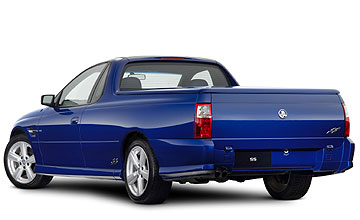BY MARTON PETTENDY | 24th Aug 2004

Under the bonnet of Ute and Ute S now lies the same Alloytec V6 that powers Commodore Executive, Acclaim and Berlina sedans and wagons, delivering 175kW at 6000rpm and 320Nm of torque at 2800rpm (not at a lower 2400rpm as in VZ Crewman and One Tonner).
That’s 14 per cent more power and five per cent more torque than the defunct 152kW/305Nm 3.8-litre pushrod Ecotec V6.
An all-alloy 24-valve DOHC design, the 60-degree V6 employs a sand-cast alloy block, forged steel crankshaft, twin knock sensors, stainless steel exhaust, roller finger valve followers, 32-bit engine management system, coil-on-plug ignition, an electronic throttle and variable inlet valve timing.
The new 3.565-litre engine, with oversquare 94 x 85.6mm bore and stroke dimensions, runs a relatively high 10.2:1 compression ratio and continues with the 15,000km regular service intervals introduced with VY Commodore’s 3.8 Ecotec V6, but it misses out on the variable exhaust valve timing and two-stage inlet manifold of the premium Alloytec 190 V6 found in SV6, Calais, Statesman and Caprice sedans.
Similarly, Commodore Utes miss out on those models’ new five-speed automatic transmission featuring Active Select steering wheel-mounted gearshift buttons.
Instead, there’s a comprehensively upgraded version of Commodore’s current GM four-speed auto, which features a new torque converter, smarter control module and new calibration to improve shift-to-shift variation.
But the big transmission news for Ute is the standard fitment of a brand-new D173 Aisin six-speed manual manufactured in Japan to replace the five-speed Getrag previously available in base Ute variants with a lower (3.08:1 versus sedan models’ 2.87:1) final drive ratio.
In line with VZ SS (and SV8 and Caprice) sedan, VZ Ute SS gets a revised V8 with larger 95mm cold air intake, a new exhaust and revised ECU software to liberate an extra 5kW and 5Nm.
Now producing 250kW at 5600rpm and 470Nm of torque at 4800rpm, Holden’s most powerful iteration of the 5.7-litre pushrod Gen III delivers more than 44kW per litre - as much as the first Chev-powered HSV ClubSport released in 1999.
More importantly, SS is once again lineball for engine performance with its most direct rival in Ford’s XR8 (which produces 260kW and 500Nm from its 5.4-litre DOHC V8) given, as Holden is at pains to point out, that Holden measures all its performance figures in the more widely recognised ECE format rather than the more generous DIN measurement favoured by Ford. The V8 also benefits from a new electronic throttle.
Ute V6 auto fuel economy drops one point, from 11.9 to 11.8 litres per 100km, while the V8’s electronic throttle and engine recalibration sees Ute SS auto fuel economy drop from 13.9 to 13.5L/100km.
While Ute SS’s six-speed Tremec manual is carried over, SS autos receive a new torque converter with 13 times greater electronic smarts, plus a new hydraulic controller aimer at delivering smoother, less shocking shifts.
Ute also benefits from steering tweaks across the VZ Commodore range, which include a different front anti-roll bar pickup point (now ball-jointed, not rubber bushed) which reduces both its mass and bar crank length by 40mm to "increase the range of mild understeer at low to mid lateral G-forces".
While all VZ Utes score a new brake master-cylinder and booster claimed to achieve ABS-invoking pressure in half the time and to reduce stopping distances by four per cent, only ABS-equipped V6 Utes offer the latest Bosch 8.0 ABS system with brake assist and electronic brake-force distribution.
ABS remains optional on the base Ute, Ute SS continues with Bosch 5.3 ABS and there is no traction control, let alone selected V6 VZ sedans’ ESP stability control.
There is, however, extra standard equipment for the base Utes, which rises in price by just $300, in the shape of power windows and cruise control.
With the more complex overhead-cam cylinder-heads of the new V6 negating much of the alloy engine construction’s weight savings, VZ Ute kerb weights remain almost lineball with the outgoing VYII.
For the base V6 they are 1535kg manual and 1538kg auto, with Ute S weighing 1549kg manual and 1552kg auto and Ute SS weighing 1613kg manual and 1619kg auto.
Similarly, Ute payloads are now 830kg manual/827kg auto, with Ute S able to haul 726kg manual and 723kg auto and Ute SS 662kg manual and 656kg auto.
Towing capacity, however, has increased by 30 per cent thanks to a 14mm larger clutch (now 294mm) in manual V6 models, which can now tow the same 1600kg as automatic V6 Utes (up 30 per cent from 1200kg with the outgoing five-speed Getrag manual).
VZ Ute’s revised front-end styling including a new ridged bonnet, compact headlights (with black bezelled projector beams on SS), a single-bar sports grille with large Holden logo and new front bumper with larger air intake.
Of course, the SS bodykit is more aggressive and features exclusive new side fender vents - representing the only sheetmetal change on VZ – that actually don’t vent anything and simply house the clear side repeater lenses.
Holden lists the base Ute manual price at $28,540 including air-conditioning, which is optional at $2250, while Ute S manual is listed at $32,620 and the revised auto adds $770 to both variants.
VZ Ute SS is priced at $40,640 with both a carry-over six-speed Tremec manual or revised four-speed auto.